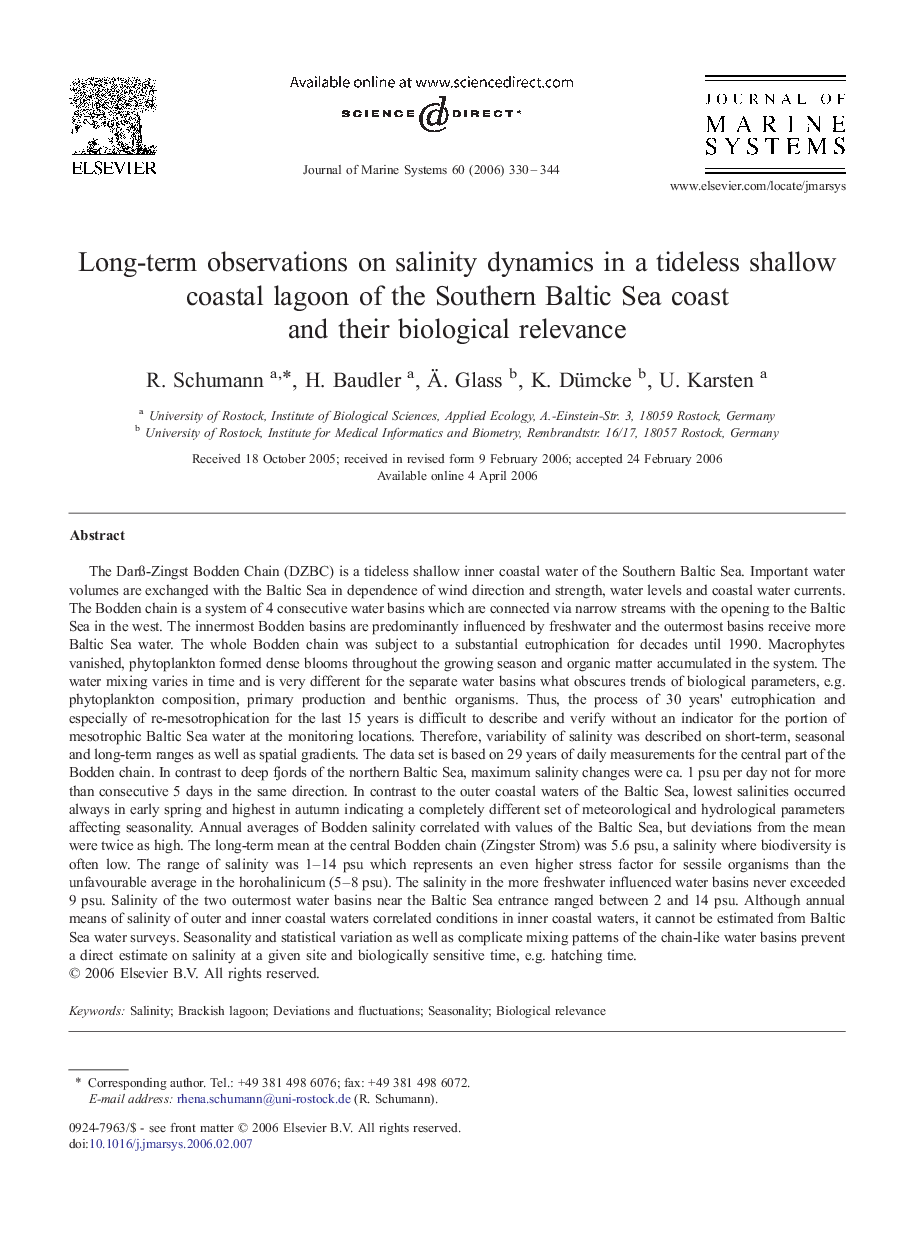| کد مقاله | کد نشریه | سال انتشار | مقاله انگلیسی | نسخه تمام متن |
|---|---|---|---|---|
| 4549416 | 1627366 | 2006 | 15 صفحه PDF | دانلود رایگان |
عنوان انگلیسی مقاله ISI
Long-term observations on salinity dynamics in a tideless shallow coastal lagoon of the Southern Baltic Sea coast and their biological relevance
دانلود مقاله + سفارش ترجمه
دانلود مقاله ISI انگلیسی
رایگان برای ایرانیان
کلمات کلیدی
موضوعات مرتبط
مهندسی و علوم پایه
علوم زمین و سیارات
اقیانوس شناسی
پیش نمایش صفحه اول مقاله

چکیده انگلیسی
The DarÃ-Zingst Bodden Chain (DZBC) is a tideless shallow inner coastal water of the Southern Baltic Sea. Important water volumes are exchanged with the Baltic Sea in dependence of wind direction and strength, water levels and coastal water currents. The Bodden chain is a system of 4 consecutive water basins which are connected via narrow streams with the opening to the Baltic Sea in the west. The innermost Bodden basins are predominantly influenced by freshwater and the outermost basins receive more Baltic Sea water. The whole Bodden chain was subject to a substantial eutrophication for decades until 1990. Macrophytes vanished, phytoplankton formed dense blooms throughout the growing season and organic matter accumulated in the system. The water mixing varies in time and is very different for the separate water basins what obscures trends of biological parameters, e.g. phytoplankton composition, primary production and benthic organisms. Thus, the process of 30Â years' eutrophication and especially of re-mesotrophication for the last 15Â years is difficult to describe and verify without an indicator for the portion of mesotrophic Baltic Sea water at the monitoring locations. Therefore, variability of salinity was described on short-term, seasonal and long-term ranges as well as spatial gradients. The data set is based on 29Â years of daily measurements for the central part of the Bodden chain. In contrast to deep fjords of the northern Baltic Sea, maximum salinity changes were ca. 1Â psu per day not for more than consecutive 5Â days in the same direction. In contrast to the outer coastal waters of the Baltic Sea, lowest salinities occurred always in early spring and highest in autumn indicating a completely different set of meteorological and hydrological parameters affecting seasonality. Annual averages of Bodden salinity correlated with values of the Baltic Sea, but deviations from the mean were twice as high. The long-term mean at the central Bodden chain (Zingster Strom) was 5.6Â psu, a salinity where biodiversity is often low. The range of salinity was 1-14Â psu which represents an even higher stress factor for sessile organisms than the unfavourable average in the horohalinicum (5-8Â psu). The salinity in the more freshwater influenced water basins never exceeded 9Â psu. Salinity of the two outermost water basins near the Baltic Sea entrance ranged between 2 and 14Â psu. Although annual means of salinity of outer and inner coastal waters correlated conditions in inner coastal waters, it cannot be estimated from Baltic Sea water surveys. Seasonality and statistical variation as well as complicate mixing patterns of the chain-like water basins prevent a direct estimate on salinity at a given site and biologically sensitive time, e.g. hatching time.
ناشر
Database: Elsevier - ScienceDirect (ساینس دایرکت)
Journal: Journal of Marine Systems - Volume 60, Issues 3â4, May 2006, Pages 330-344
Journal: Journal of Marine Systems - Volume 60, Issues 3â4, May 2006, Pages 330-344
نویسندگان
R. Schumann, H. Baudler, Ã. Glass, K. Dümcke, U. Karsten,